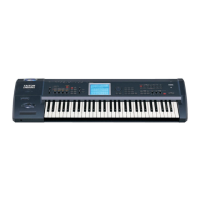Program
P0
P1 P2 P3 P4 P5 P7 P8 P9
27
Offset settings and pitch change produced by vibrato
Key Sync. [Off, On]
On (checked): The LFO will start each time you press a key,
and an independent LFO will run for each note.
Off (unchecked): The LFO effect that started when the first
key was pressed will also apply to subsequently-played
notes. (In this case, the delay and fade effects will apply only
to the first-started LFO.)
Fade [00…99]
Specifies the time from when the LFO begins to apply until
it reaches the maximum amplitude. When “Key Sync.” is
Off, the fade will apply only when the LFO is first started.
How “Fade” affects the LFO (when “Key Sync.” is On)
Delay [0…99]
Specifies the time from note-on until the LFO effect begins to
apply.
When “Key Sync.” is Off, the delay will apply only when
the LFO is first started.
5–1b: Frequency Modulation
You can use two alternate modulation sources to adjust the
speed of the OSC1 LFO1.
AMS1 (Freq. AMS1)
[Off, (PEG, FEG, AEG, LFO2, KT, EXT)]
Selects the source that will adjust the frequency of the oscil-
lator 1 LFO1 (“AMS List” ☞p.272). OSC1 LFO1 can be mod-
ulated by OSC1 LFO2.
Intensity (AMS1 Intensity) [–99…+99]
Specifies the depth and direction of the effect that “AMS1
(Freq. AMS1)” will have.
When this parameter is set to a value of 16, 33, 49, 66, 82, or
99, the LFO frequency being can be increased by a maxi-
mum of 2, 4, 8, 16, 32, or 64 times respectively (or decreased
by 1/2, 1/4, 1/8, 1/16, 1/32, or 1/64 respectively).
For example if “AMS1 (Freq. AMS1)” is Note Number, pos-
itive (+) values of this parameter will cause the oscillator 1
LFO to speed up as you play higher notes. Negative (–) val-
ues will cause the oscillator 1 LFO to slow down as you play
higher notes. This change will be centered on the C4 note.
If “AMS1 (Freq. AMS1)” is set to JS +Y: CC#01, higher set-
tings for this parameter will cause the OSC1 LFO speed to
become proportionately faster when you move the joystick.
With a setting of +99, the LFO speed will be approximately
64 times faster when the joystick is pushed all the way away
from yourself.
AMS2
(Freq. AMS2) [Off, (PEG, FEG, AEG, LFO2, KT, EXT)]
Intensity (AMS2 Intensity) [–99…+99]
Make settings for a second alternate modulation source that
will adjust the frequency of the oscillator 1 LFO1. (☞“AMS1
(Freq. AMS1),” “Intensity (AMS1 Intensity)”)
5–1c: Frequency MIDI/Tempo Sync.
MIDI/Tempo Sync. [Off, On]
On (checked): The LFO frequency will synchronize to the
tempo (MIDI Clock). In this case, the values you specified
for “Frequency” (5–1a) and Frequency Modulation (5–1b) will
be ignored.
Base Note (Sync. Base Note)
[ , , , , , , , ]
Times (Sync. Times) [01...16]
When “MIDI/Tempo Sync.” is checked, these parameters
set a note length relative to “ (Tempo)” and the multiple
(“Times”) that will be applied to it. These parameters will
determine the frequency of the OSC1 LFO1. For example if
“Base Note (Sync. Base Note)” is (quarter note) and “Times
(Sync. Times)” is 04, the LFO will perform one cycle every
four beats.
Even if you change the “ (Tempo)” setting of the arpeggia-
tor or sequencer, the LFO will always perform one cycle
every four beats.
▼ 5–1: Page Menu Command
5–1A: Swap LFO 1&2
This command exchanges the settings of LFO1 and 2. If
LFO2 has been selected as Frequency Modulation “AMS1
(Freq. AMS1)”or “AMS2 (Freq. AMS2)” (5–1b) of LFO1, that
setting will be cancelled for LFO2 after the LFO1 and 2 set-
tings have been exchanged. If this is selected from the OSC1
LFO1 or OSC1 LFO2 page, the LFO1 and LFO2 of OSC1 will
be exchanged.
1 Select “Swap LFO 1&2” to access the dialog box.
2 Press the OK button to execute, or press the Cancel but-
ton to cancel without executing.
5–2: OSC1 LFO2
Here you can make settings for the OSC1 LFO2, which is the
second LFO that can be applied to oscillator 1. (☞“5–1:
OSC1 LFO1”) However in “Frequency Modulation” (5–1b),
the LFO cannot be selected as a modulation source in
“AMS1 (Freq. AMS1)”or “AMS2 (Freq. AMS2).”
5–3: OSC2 LFO1
This can be used when “Oscillator Mode” (1–1a) is set to
Double.
Here you can make settings for the OSC2 LFO1, which is the
first LFO that can be applied to oscillator 2 (☞“5–1: OSC1
LFO1”).
5–4: OSC2 LFO2
This can be used when “Oscillator Mode” (1–1a) is set to
Double.
Here you can make settings for the OSC2 LFO2, which is the
second LFO that can be applied to oscillator 2 (☞“5–1: OSC1
LFO1” and “5–2: OSC1 LFO2”).
offset = –99 offset = 0 offset = +99Pitch
Pitch at note-on
Note-on Note-off
“Fade”
“Delay”
0–1A
5–1A

